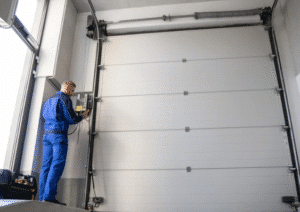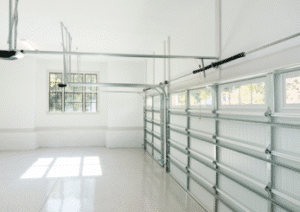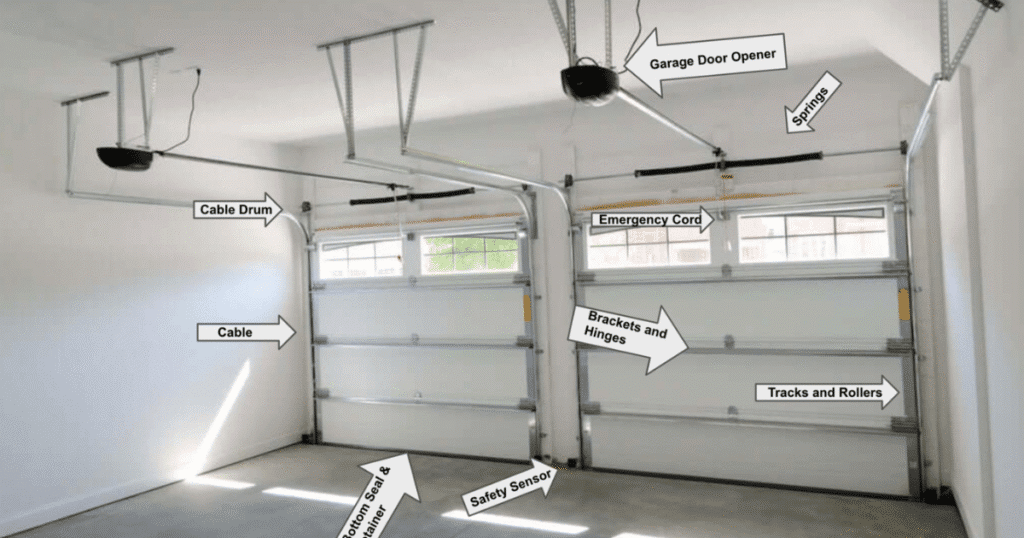Discover key parts of a garage door system and what homeowners should know before a repair or upgrade.
A garage door might appear straightforward at first glance, but homeowners quickly discover it’s far more complex when it suddenly won’t open or close. More than just a panel on hinges, it operates as a carefully balanced system of mechanical components, each one essential to safe and smooth functionality. When one element fails, the system can become unreliable or hazardous, leading to costly repairs or safety concerns.
That’s why understanding the parts of a garage door system is so valuable. Every piece, from springs and tracks to rollers and openers, is crucial to the door’s overall performance. Understanding how these parts function together helps homeowners make smarter maintenance decisions and recognize early signs of wear. For expert guidance and reliable service, turn to Tarrant County Door and Gate, your trusted partner in professional garage door repair and support.

Why It’s Important to Understand the Parts of a Garage Door System
Garage doors are used daily, yet most people only think about them when something goes wrong. Familiarity with the parts of a garage door system helps you:
- Spot issues early and avoid costly emergencies.
- Communicate effectively with service professionals.
- Make confident, informed decisions when it’s time for repair or replacement.
A little knowledge goes a long way when protecting your investment and safety.
How Tarrant County Door and Gate Simplifies Repairs
Tarrant County Door and Gate makes the repair process easy to understand when your garage door has issues. Our trained technicians provide:
- Comprehensive assessments of all system components.
- Clear explanations and repair options based on your specific issue.
- Preventative maintenance to keep your door running smoothly.
When working with a proper local authority, we take pride in delivering honest service, long-term solutions, and peace of mind.
Garage Door Panels
The panels are the large, visible sections of your garage door. Often made from steel, aluminum, wood, or fiberglass, they contribute to curb appeal, insulation, and overall strength.
Standard Panel Issues and When to Replace
Panel problems typically include:
- Dents or cracks from impact.
- Rust and corrosion on metal doors.
- Sagging due to wear or weather.
While minor damage can sometimes be repaired, structural issues usually require full panel replacement. Tarrant County Door and Gate can match new panels to your existing door for a consistent look and reliable function.
Garage Door Springs
Springs counterbalance the door’s weight, making it easy to lift manually or with an opener. There are two primary types:
- Torsion springs, mounted above the door.
- Extension springs, located along the sides.
Why You Should Never DIY Spring Repairs

A broken spring can be dangerous. These components are under high tension, and improper handling can cause serious injury. That’s why spring repair and replacement should always be left to professionals. Tarrant County Door and Gate uses industry-grade tools and safety techniques to ensure secure, long-lasting repairs.
Garage Door Tracks and Rollers
Tracks are the metal rails that guide your door up and down. Rollers fit into the tracks and help the door move smoothly. Together, they allow your door to open and close with ease.
Signs of Track or Roller Wear
Warning signs include:
- Loud grinding or squeaking
- Uneven or jerky movement
- The door is sticking or leaning to one side
Misalignment or wear can cause excessive strain on other parts. The Tarrant County Door and Gate team expertly aligns or replaces tracks and rollers to restore smooth operation.
Garage Door Opener and Motor Unit
The motorized opener does the heavy lifting behind the scenes. It receives signals from your remote, keypad, or smart home system and opens or closes the door accordingly.
Compatibility and Upgrades
Not every opener fits every door. Factors like door weight and size must be considered. Upgrading can improve safety and convenience if your opener is outdated or underpowered. Tarrant County Door and Gate offers modern openers with innovative features like Wi-Fi control and rolling-code security for maximum performance.
Garage Door Cables and Pulleys
Cables work with the springs to lift and lower the door. They wrap around drums and connect to brackets at the base of the door, providing controlled movement.
When to Inspect Your Cables
Keep an eye out for:
Slack or Sagging Cables
If your garage door cables appear loose or hang unevenly, it may signal wear or improper tension. Left unchecked, slack cables can disrupt door balance and lead to mechanical failure.
Jerky Motion When Opening or Closing
A garage door that opens or closes with sudden jolts or uneven motion often points to cable misalignment or wear. This not only strains the system but also increases safety risks.
Visible Fraying or Snapping Strands
If you notice broken wires or frayed sections in your cables, it’s time for replacement. These signs indicate weakening tension and can result in unexpected breaks or complete failure.
These are signs that your cables may be compromised. Tarrant County Door and Gate provides fast, professional cable inspections and replacements to prevent further system damage or safety hazards.
Hinges, Brackets, and Hardware
These smaller parts help panels bend, hold the system together, and keep everything aligned. Though not always visible, they’re vital for smooth movement and safe operation.
Why These Parts Matter More Than You Think
Neglecting small hardware can lead to larger issues. A loose hinge can cause misalignment, and a worn bracket can cause vibrations or shifts. As part of our full-system inspections, Tarrant County Door and Gate carefully checks and tightens all hardware to maintain peak performance.
Safety Sensors and Limit Switches

Modern garage doors include built-in safety systems. Sensors prevent the door from closing on objects or people, and limit switches control the door’s travel distance.
When to Calibrate or Replace Sensors
You might need a sensor check if:
The Door Reverses Unexpectedly
If your garage door reverses suddenly after touching the floor, it may indicate a problem with the close-limit setting or sensor alignment. A professional inspection can quickly resolve this issue.
It Won’t Close All the Way
When your door won’t fully shut, check for debris on the track or misaligned sensors. If the problem persists, expert adjustments or repairs may be needed to ensure safe operation.
Sensor Lights Blink or Fail
Flashing or non-responsive sensor lights typically signal alignment problems or wiring issues. Cleaning the sensor lenses and ensuring nothing blocks their path can help, but expert calibration is often required.
Safety features are non-negotiable. Our team ensures your system meets all safety standards by replacing or recalibrating these components as needed.
FAQ: Parts of a Garage Door System
What are the garage door parts?
Garage door parts include springs, rollers, tracks, hinges, cables, panels, weather seals, and sensors. These components work together to ensure smooth operation, balance, and safety. Regular maintenance helps prevent breakdowns and extends the life of your garage door system. Each part plays a specific, essential role.
What is a garage door mechanism called?
The mechanism that powers a garage door is called the garage door system or assembly. This includes the springs, opener, tracks, and other moving parts that enable lifting and lowering. Proper function of this mechanism ensures smooth, secure, and reliable garage door operation.
What are garage door sections?
Garage door sections are the horizontal panels that make up the whole door. Typically made of steel, wood, or aluminum, these sections are connected by hinges and bend as the door opens. Most residential garage doors have three to five sections that allow smooth upward movement along the tracks.
What is the part called that opens the garage door?
The part that opens the garage door is called the garage door opener. This motorized device, controlled by a remote or wall switch, powers the lifting and lowering of the door through a chain, belt, or screw drive. It’s essential for convenience, security, and hands-free operation.
What are garage door openers called?
Garage door openers are motorized units often called garage door motors or garage door operators. These devices use mechanisms like chain drive, belt drive, or screw drive to raise and lower the door. Modern models often feature innovative technology for remote access and enhanced security features.
Conclusion: Why Every Part Counts
Tarrant County Door and Gate believes that knowing the parts of a garage door system puts homeowners in control. Each part matters, from the springs that handle tension to the rollers that guide the door’s motion. By understanding how these components work together, you can better identify problems and take action before they become costly repairs.
Familiarity with the parts of a garage door system improves safety and boosts confidence when seeking service or maintenance. Tarrant County Door and Gate is here to help you make informed choices about your garage door. When every piece, from cables to openers, is understood, it’s easier to maintain long-term performance and avoid unexpected breakdowns.
End Note
Tarrant County Door and Gate is your trusted source for expert garage door and gate services across the region. Whether you need garage door repair, drive gate installation, or simply want to explore our gallery for inspiration, we’re here to help. Learn more about our team and read helpful tips on our blog to stay ahead of issues before they start.
For fast, reliable service, contact us online or connect with us through Facebook to see what sets us apart. From emergency repairs to custom upgrades, we handle every project with precision and care. Visit our official website to schedule your appointment today. With Tarrant County Door and Gate, you’ll get lasting results and unmatched customer support every step of the way.
Tarrant County Door and Gate
1905 Central Dr # 206, Bedford, TX 76021, United States
817-270-9884

